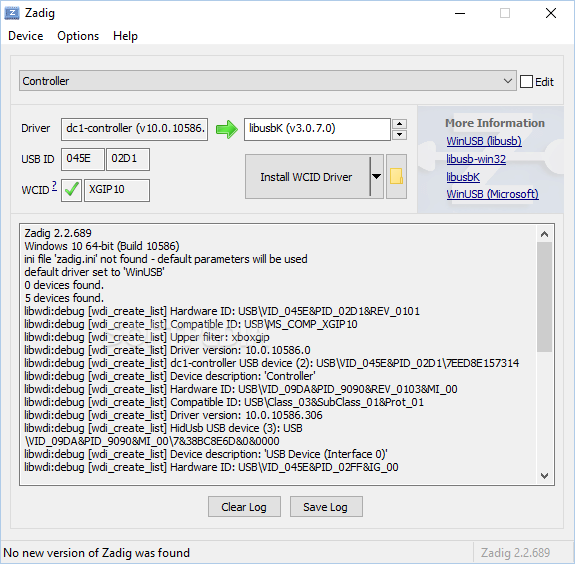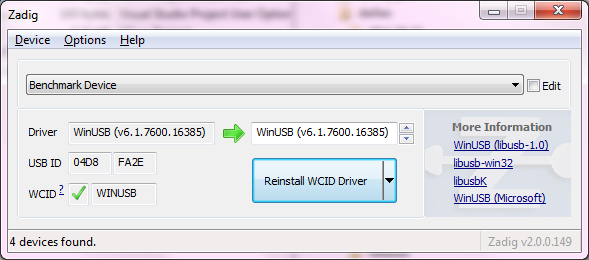In addition to the previous suggestions, you can also find the recent oem##.inf in C: Windows inf that matches the device's VID/PID (you’ll need to grep/find inside those files to find the appropriate one – or find the registry keys for the device that reference the correct oem##.inf file), then delete the inf file so Windows can’t automatically install the drivers again next time you.
- Remove Libusbk Driver
- Libusbk Nintendo Switch Driver
- Libusbk Driver
- Libusbk Driver Switch
- Libusbk Driver Install
- Choose libusbK from the driver list and click the 'Replace Driver' button. Start tinfoil on the switch, and either connect the USB cable from the switch to your PC, or set up a nut server location using the information displayed in nut server.
- Methods for installing the libusbK binaries and drivers. Use the InfWizardprovided in the bin and dev-kit packages to generate and optionally install the inf driver package automatically. Once a package has been generated it can used again an subsequent installs.
Windows
The driver includes files for USB and the library uDMX.dll. The USB-files are always used, uDMX.dll is used depending on the lighting software.
As driver installation became more problematic with each newer Windows-version there are several uDMX-drivers that can be installed / tried.
- libusbK: all tested programs worked fine. Try this driver first. DOWNLOAD
- WinUSB: likely more compatile with Windows but not all software worked. uDMXArtnetP5 worked fine, uDMXArtnet did not work. DOWNLOAD
- libusb: the old driver. Not the best solution for Windows 10. DOWNLOAD
INSTALLATION
- Download at least one of the listed drivers
- Uncompress the file whereever you want and then plugin the hardware.
- The operating system will search for a driver.
- Select the file uDMX.inf in the selected directory (of your uncompression)
- After several seconds the driver should be installed. On newer Windows-versions you have to accept that the driver is not digitally signed. If you got problems, please read the FAQ.
- ATTENTION: At this time the file uDMX.dll has to be MANUALLY copied to the directory <Windows>System32 !
Screenshot: installed uDMX-libusbK-driver on Windows10-64Bit and running artnet-programs.
CONFIGURATION
You can change the following values. Times can only be changed when you use uDMX firmware >= 1.4.
- Number of Channels: can be changed from the default of 512 to a lower value.
- Maximal Bytes to transfer: all tested windows programs only support 1 Byte at a time. Anyhow you should test the value 512 and only reduce the value if you experience problems.
- Break (Reset): Reset time before sending the first DMX value (default 88µs)
- Mark: Time between Reset and startbyte (default 8µs)
- Gap: time between the DMX values (default 0µs). Has to be changed for some devices like Eurolite TS-5, Laserworld EL200RGY ... Set value to 20 for those devices.
START CONFIGURATION
If your DMX software does not support starting uDMX configuration, you can call the configuration using the script uDMXConfigure.bat (included in the driver files).
Testing uDMX
To test the uDMX interface, you can start a simple test-dialog from within the configuration dialog.
With the sliders it is possible to set the values of channels 1-6. The values of these channels are sent to the interface.
LINUX
When using Linux you have to install libusb. Normally programs have to be run as root to get access to usb-devices. To avoid this, create a file z65-anyma-udmx.rules in folder /etc/udev/rules.d with the following content:
SUBSYSTEM'usb*', ACTION'add|change', ATTRS{idVendor}'16c0', ATTRS{idProduct}'05dc', MODE='0666'
SUBSYSTEM'usb*', ACTION'add|change', SYSFS{idVendor}'16c0', SYSFS{idProduct}'05dc', MODE='0666'
MacOSX
probably like Linux


iPi Recorder supports multiple Kinects v2 on a single PC using libfreenect2 instead of Microsoft Kinect SDK v2.
To use this, first you need to enable corresponding camera type in iPi Recorder. Open Camera Types panel and hit ENABLE next to Microsoft Kinect 2 (libfreenect2). Alternatively, open Add Device dropdown and select Kinect 2 for Windows (multiple sensors per PC).

Next you need to install a driver for Kinect that makes it accessible to libfreenect2. There are two options - UsbDk and libusbK.
We recommend to start with UsbDk as an easier option. And turn to libusbK if:
- You have troubles installing UsbDk.
- It doesn't work as expected. E.g. Kinect is not visible in iPi Recorder when libfreenect2 support is on, or works unstable.
- It causes problems with other USB devices.
- 2libusbK
Just download and install the latest release (1.0.19 as of the moment of writing) and you are done. iPi Recorder can use Kinect v2 devices via libfreenect2. Moreover, because of the smart way UsbDk handles driver replacement you can still use other programs which work with Kinect in a standard way via MS Kinect SDK 2.0.
This driver can be installed using Zadig tool. There are few drawbacks compared to UsbDk:
- (Un)installation of the driver is more complicated (see below).
- While libusbK driver is installed for Kinect, programs which rely on MS Kinect SDK won't see the device.
Install
Remove Libusbk Driver
- Run Zadig tool (2.4 as of the moment of writing).
- Connect Kinect v2 to a PC.
- Under Options menu, check List All Devices and uncheck Ignore Hubs or Composite Parents.
- Then select Xbox NUI Sensor (Composite Parent) from the device combo.
- Select libusbK driver and hit Replace Driver button.
- Click Yes in confirmation dialog which appears after a few seconds.
- Upon successful installation of the driver close Zadig.
Now Kinect is available to libfreenect2 in iPi Recorder.
Libusbk Nintendo Switch Driver
Uninstall
- Connect Kinect v2 to a PC.
- Open Windows Device Manager.
- Locate Xbox NUI Sensor (Composite Parent) device, right-click and select Uninstall device.
- In uninstall dialog, check Delete the driver software for this device.
- Scan for hardware changes, and MS Kinect SDK driver will be restored automatically.

Libusbk Driver
We have tested libfreenect2 support with a number of USB 3.0 controllers. Here are some findings:
- Intel (built-in), 200 series and above chipsets
- Stable work of dual Kinects with occasional frame drops.
- Intel (built-in) other
- Stable work of a single Kinect. With two connected, there are frame drops and low frame rate issues.
- Works with 5m active USB 3.0 extension cable.
- No depth data with 1.8m passive USB 3.0 extension cable.
- NEC μ720202 (PCIe card)
- Stable work of a single Kinect. With two connected, Windows reports insufficient USB bandwidth for one of them.
- Unstable work with 5m active USB 3.0 extension cable - frame drops.
- Unstable work with 1.8m passive USB 3.0 extension cable - frame drops, low frame rate.
- Tip: PCIe cards with multiple μ720202 chips onboard exist that should be capable of connecting 1 Kinect device per chip.
- StarTech PEXUSB3S42V with 2 chips
- StarTech PEXUSB3S44V with 4 chips
- ASMedia ASM1042A (built-in).
- Stable work of two Kinects with rare FPS issues.
- VIA VL800 (PCIe card). Doesn't work.
- Etron EJ168 (built-in). Doesn't work.
Libusbk Driver Switch
